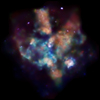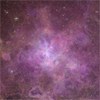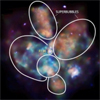CXC Home | Search | Help | Image Use Policy | Latest Images | Privacy | Accessibility | Glossary | Q&A
Tour of 30 Doradus
Quicktime MPEG
Chandra's X-ray image of the Tarantula Nebula gives scientists a close-up view of the drama of star formation and star evolution. The Tarantula, also known as 30 Doradus, is one of the most active star-forming regions in a galaxy close to the Milky Way. Massive stars in 30 Doradus are producing intense radiation and searing winds of multimillion-degree gas. These winds carve out gigantic super-bubbles in the surrounding gas as seen in the Chandra data. Other massive stars have raced through their evolution and exploded catastrophically as supernovas. These events leave behind pulsars and expanding remnants that trigger the collapse of giant clouds of dust and gas to form new generations of stars.
[Runtime: 00:48]
Quicktime MPEG
Chandra's X-ray image of the Tarantula Nebula gives scientists a close-up view of the drama of star formation and star evolution. The Tarantula, also known as 30 Doradus, is one of the most active star-forming regions in a galaxy close to the Milky Way. Massive stars in 30 Doradus are producing intense radiation and searing winds of multimillion-degree gas. These winds carve out gigantic super-bubbles in the surrounding gas as seen in the Chandra data. Other massive stars have raced through their evolution and exploded catastrophically as supernovas. These events leave behind pulsars and expanding remnants that trigger the collapse of giant clouds of dust and gas to form new generations of stars.
[Runtime: 00:48]
(Credit: (NASA/CXC/Penn State/L.Townsley, et al.)
Zoom into Chandra's Image of 30 Doradus
Quicktime MPEG
Beginning with an optical image of the Large Magellanic Cloud where 30 Doradus is located, the view then zooms into to show the activity Chandra sees in X-rays. Giant superbubbles have been created by output from massive stars. A star cluster in the center, known as R136, is at the intersection of three of these superbubbles. In this image, red represents the lower range of X-rays that Chandra detects, the medium range is green, while the highest-energy X-rays are blue.
[Runtime: 00:14]
Quicktime MPEG
Beginning with an optical image of the Large Magellanic Cloud where 30 Doradus is located, the view then zooms into to show the activity Chandra sees in X-rays. Giant superbubbles have been created by output from massive stars. A star cluster in the center, known as R136, is at the intersection of three of these superbubbles. In this image, red represents the lower range of X-rays that Chandra detects, the medium range is green, while the highest-energy X-rays are blue.
[Runtime: 00:14]
(Credit: X-ray: NASA/CXC/Penn State/L.Townsley, et al.; Optical: NOAO/AURA/NSF/S.Points, C.Smith & MCELS team)
Annotated Chandra Image of 30 Doradus
Quicktime MPEG
This version of Chandra's image of 30 Doradus outlines the superbubbles detected in the X-ray emission. These bubbles - generated from intense radiation and strong winds from massive stars - are carved into the cooler surrounding gas and dust (not seen in X-rays). The cluster R136 is found where three of these superbubbles meet and is also marked in this version.
[Runtime: 00:08]
Quicktime MPEG
This version of Chandra's image of 30 Doradus outlines the superbubbles detected in the X-ray emission. These bubbles - generated from intense radiation and strong winds from massive stars - are carved into the cooler surrounding gas and dust (not seen in X-rays). The cluster R136 is found where three of these superbubbles meet and is also marked in this version.
[Runtime: 00:08]
(Credit: NASA/CXC/Penn State/L.Townsley, et al.)
Return to 30 Doradus (December 11, 2008)





